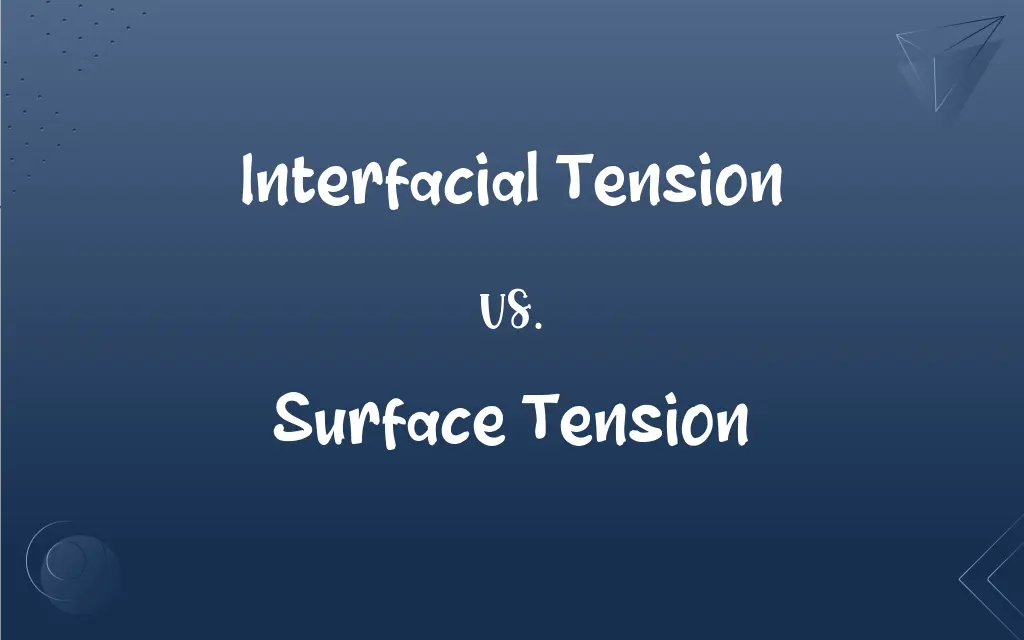Interfacial Tension vs. Surface Tension: What's the Difference?
Edited by Harlon Moss || By Janet White || Published on February 16, 2024
Interfacial tension is the force per unit length at the interface between two different phases, such as oil and water; surface tension is the force per unit length at the interface between a liquid and gas, such as water and air.

Key Differences
Interfacial tension refers to the tension at the interface between two different liquids or a liquid and a solid, driven by the disparity in molecular attraction across this boundary. Surface tension, in contrast, is specific to the interface between a liquid and a gas, mainly influenced by the cohesive forces within the liquid itself.
In interfacial tension, the key factor is the differing molecular interactions between two distinct phases, leading to a balance of forces at their interface. Surface tension, however, arises from the imbalance of molecular cohesive forces within a liquid, as molecules at the surface experience a net inward force due to the absence of similar molecules in the gas phase above.
Interfacial tension plays a crucial role in processes like emulsification and oil recovery, where the interaction between different substances is critical. Surface tension is fundamental in phenomena such as capillary action and the formation of droplets, relying on the liquid-gas interface properties.
The measurement of interfacial tension often involves techniques like the spinning drop method, focusing on the interaction between two distinct substances. Surface tension, however, is commonly measured through methods like the Du Noüy ring, which examines the force needed to pull a ring from the liquid’s surface.
Interfacial tension affects properties like wetting, spreading, and adhesion, especially important in coatings and adhesives. Surface tension influences phenomena like bubble formation and the behavior of liquids in confined spaces, crucial in inkjet printing and microfluidics.
ADVERTISEMENT
Comparison Chart
Definition
Tension at interface between two different phases
Tension at liquid-gas interface
Influencing Factors
Molecular interactions between different substances
Cohesive forces within a liquid
Key Importance
In processes like emulsification, oil recovery
In capillary action, droplet formation
Measurement Techniques
Spinning drop method, pendant drop method
Du Noüy ring, capillary rise method
Impact on Material Properties
Wetting, spreading, adhesion characteristics
Bubble formation, behavior in confined spaces
ADVERTISEMENT
Interfacial Tension and Surface Tension Definitions
Interfacial Tension
Interfacial tension quantifies the force at the boundary between two immiscible phases.
The interfacial tension between oil and water dictates the size of oil droplets in an emulsion.
Surface Tension
Surface tension is the force that causes a liquid’s surface to contract and resist external forces.
Water droplets bead up on a waxed car due to surface tension.
Interfacial Tension
Interfacial tension is the measure of the cohesive force at an interface.
High interfacial tension between a liquid and a solid can prevent proper coating adhesion.
Surface Tension
Surface tension is a measure of the cohesive forces at a liquid’s surface.
Insects like water striders exploit surface tension to walk on water.
Interfacial Tension
It's the energy required to increase the interface between two phases.
Surfactants lower the interfacial tension, making it easier to mix oil and water.
Surface Tension
Surface tension is the differential attraction of molecules at a liquid’s surface.
Surface tension is the reason raindrops form spherical shapes as they fall.
Interfacial Tension
Interfacial tension is the differential attraction between molecules at a boundary.
In drug delivery systems, interfacial tension affects the release rate of active ingredients.
Surface Tension
It represents the resistance of a liquid to spread out and increase its surface area.
Mercury’s high surface tension causes it to form spherical droplets on surfaces.
Interfacial Tension
It represents the resistance to the formation of a new surface between two different phases.
Interfacial tension is crucial in determining the stability of emulsions in food products.
Surface Tension
It's the energy required to increase a liquid's surface area.
Soap bubbles are stable due to the surface tension of the soapy water.
FAQs
How do surfactants affect interfacial tension?
Surfactants reduce interfacial tension, facilitating the mixing of immiscible liquids.
How does temperature influence surface tension?
Generally, surface tension decreases with increasing temperature.
What is interfacial tension?
It's the force at the boundary between two different phases, like oil and water.
What happens to surface tension when detergents are added to water?
Detergents lower the surface tension, allowing water to spread more easily.
What role does surface tension play in nature?
It's crucial for phenomena like capillary action and the floating of some insects on water.
What is surface tension?
Surface tension is the force at a liquid’s surface, particularly at the liquid-gas interface.
How is interfacial tension measured?
Techniques like the spinning drop method are commonly used.
Is interfacial tension important in medical applications?
Yes, especially in drug delivery systems where it affects drug release rates.
Can interfacial tension impact product formulation?
Yes, it's vital in formulations like emulsions and suspensions in pharmaceuticals and cosmetics.
Can surface tension be altered chemically?
Yes, by adding substances like alcohols or surfactants.
How do cleaning agents work in relation to interfacial tension?
They reduce the interfacial tension between water and oily substances, improving cleaning efficiency.
Why is interfacial tension important in oil recovery?
It affects how oil interacts with water and rock formations, influencing extraction efficiency.
Is interfacial tension relevant in food technology?
Yes, especially in the stability and texture of food emulsions like mayonnaise.
What is a practical example of surface tension in daily life?
The ability of a needle to float on water due to surface tension.
Does surface tension have an impact on weather?
Yes, it influences the formation of raindrops and cloud formation.
What is the role of surface tension in pulmonary function?
It helps maintain the structure of alveoli in the lungs.
How does surface tension affect detergency?
Lower surface tension improves a detergent’s ability to wet surfaces and remove dirt.
How does interfacial tension affect emulsion stability?
Higher interfacial tension can lead to less stable emulsions.
Can surface tension influence industrial processes?
Absolutely, it's crucial in processes like painting, coating, and inkjet printing.
What factors affect interfacial tension?
Factors like temperature, pressure, and the nature of the substances involved.
About Author
Written by
Janet WhiteJanet White has been an esteemed writer and blogger for Difference Wiki. Holding a Master's degree in Science and Medical Journalism from the prestigious Boston University, she has consistently demonstrated her expertise and passion for her field. When she's not immersed in her work, Janet relishes her time exercising, delving into a good book, and cherishing moments with friends and family.
Edited by
Harlon MossHarlon is a seasoned quality moderator and accomplished content writer for Difference Wiki. An alumnus of the prestigious University of California, he earned his degree in Computer Science. Leveraging his academic background, Harlon brings a meticulous and informed perspective to his work, ensuring content accuracy and excellence.
































































